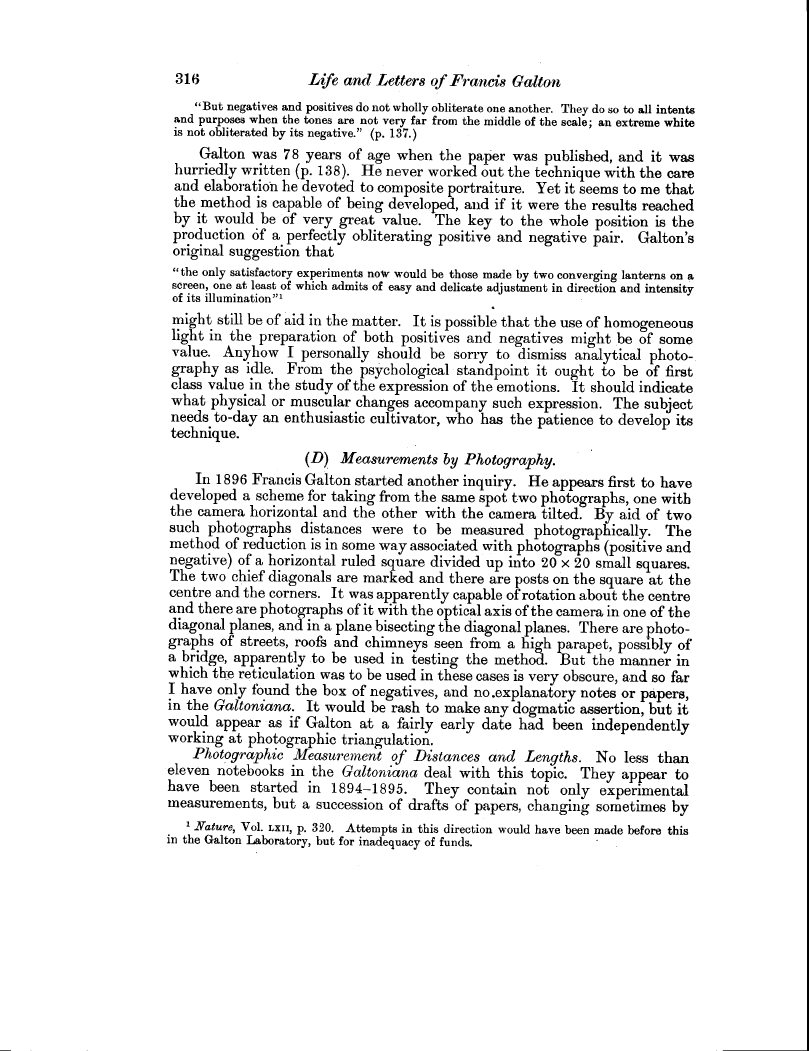316 Life and Letters of Francis Galton
"But negatives and positives do not wholly obliterate one another. They do so to all intents and purposes when the tones are not very far from the middle of the scale; an extreme white is not obliterated by its negative." (p. 13 1".)
Galton was 78 years of age when the paper was published, and it was hurriedly written (p. 138). He never worked out the technique with the care and elaboration he devoted to composite portraiture. Yet it seems to me that the method is capable of being developed, and if it were the results reached by it would be of very great value. The key to the whole position is the production of a perfectly obliterating positive and negative pair. Galton's original suggestion that
"the only satisfactory experiments now would be those made by two converging lanterns on a screen, one at least of which admits of easy and delicate adjustment in direction and intensity of its illumination"'
might still be of aid in the matter. It is possible that the use of homogeneous light in the preparation of both positives and negatives might be of some value. Anyhow I personally should be sorry to dismiss analytical photography as idle. From the psychological standpoint it ought to be of first class value in the study of the expression of the emotions. It should indicate what physical or muscular changes accompany such expression. The subject needs to-day an enthusiastic cultivator, who has the patience to develop its technique.
(D) Measurements by Photography.
In 1896 Francis Galton started another inquiry. He appears first to have developed a scheme for taking from the same spot two photographs, one with the camera horizontal and the other with the camera tilted. By aid of two such photographs distances were to be measured photographically. The method of reduction is in some way associated with photographs (positive and negative) of a horizontal ruled square divided up into 20 x 20 small squares. The two chief diagonals are marked and there are posts on the square at the centre and the corners. It was apparently capable of rotation about the centre and there are photographs of it with the optical axis of the camera in one of the diagonal planes, and in a plane bisecting the diagonal planes. There are photographs of streets, roofs and chimneys seen from a high parapet, possibly of a bridge, apparently to be used in testing the method. But the manner in which the reticulation was to be used in these cases is very obscure, and so far I have only found the box of negatives, and no.explanatory notes or papers, in the Galtoniana. It would be rash to make any dogmatic assertion, but it would appear as if Galton at a fairly early date had been independently working at photographic triangulation.
Photographic Measurement of Distances and Lengths. No less than eleven notebooks in the Galtoniana deal with this topic. They appear to have been started in 1894-1895. They contain not only experimental measurements, but a succession of drafts of papers, changing sometimes by
1 Nature, VOl. LXII, p. 320. Attempts in this direction would have been made before this in the Galton Laboratory, but for inadequacy of funds.

